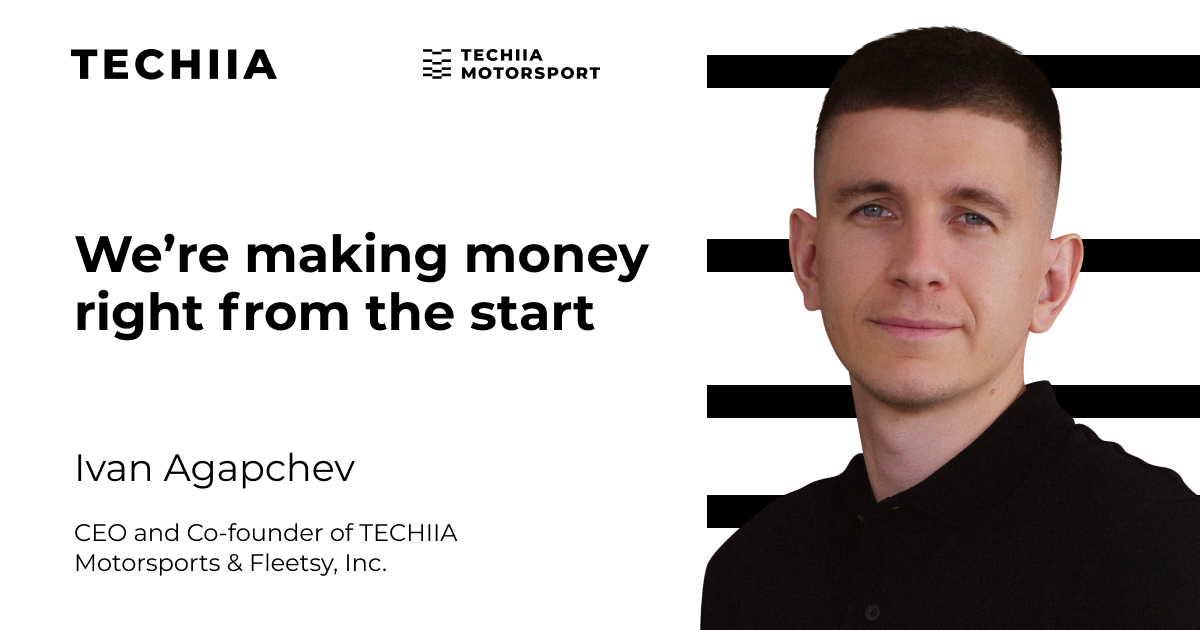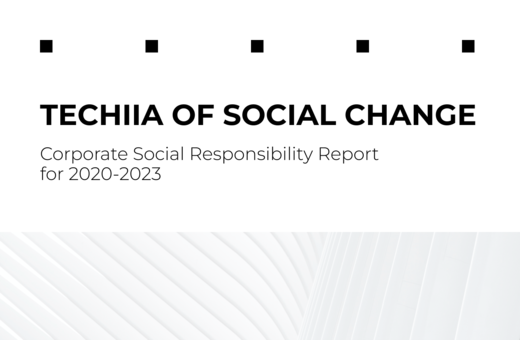
How a Ukrainian built a successful car-sharing business in the USA having no experience as a manager.
In 2021, TECHIIA holding carried on its international expansion and added several more companies to its list. One of them is a car rental service in Los Angeles, which has entered the holding under the name TECHIIA Motorsports. The business has gone from 0 to 150 cars in ownership and management in just two years. And it continues to grow. Today it is one of the largest accounts on the American car-sharing platform Turo, which has managed to develop in such a short time.
But how to build a car-sharing business without investments, while the rest are closing and selling their car fleet? We talked about this with Ivan Agapchev, TECHIIA Motorsports’ CEO. And in the future, Ivan will share his expertise with entrepreneurs in the media and our blog.
On the start of his career and moving to the USA
I was born in Kamianets-Podilskyi, where I graduated with honors from the Physics and Mathematics Lyceum. At the University of State Fiscal Service in Irpin, I received a master's degree in business economics.
After graduation in 2014, I left for the United Arab Emirates. There I changed several jobs. I was selling electronics and real estate. A couple of years later, my wife and I moved to Cyprus, where I managed a large property and rented out apartments on the seashore.
In 2017, we flew to the USA. I had to make money right away, so I started with simple jobs: food delivery, taxi. And in my free time, I was looking for more cash niches.
This is where my automotive story began. Then in the States, the business of used cars from auctions was just emerging. I bought a car, repaired and sold it in the local market, or sent it overseas. I also looked for custom-made models and earned commissions.
Before moving to the States, I didn’t know much about cars, but I quickly learned a lot. For example, I began to understand whether the car is worth the money that is asked for it, whether repairs are possible and how much it will cost.
When my friends from Ukraine offered to start a joint business of exporting used cars from the USA, I realized that the niche was full and it was time to change my profile. And indeed - now in Ukraine, big players are engaged in cars from the insurance auctions, and those guys who started transporting single cars and did not manage to grow big were forced to do something else.
On the launch of the first business
In 2019, I founded Calibri Motorsport, my first company in Los Angeles. There we made polishing, vinyl and detailing, and covered cars with protective films.
It was a small business. There are many road accidents in the United States, but some small operations with a car with no insurance companies involved do not bring significant profit. Therefore, in parallel, I received a license for bodywork and painting in order to be able to repair insured cars.
The first broken cars were brought by my friends from taxis and delivery services. Our margin was formed as the difference between the insurance premium and our repair costs. It was way more than my tuning income. I realized that it was necessary to develop body repair and cooperation with insurance companies.
Looking for new customers for a car repair shop is expensive and time-consuming. You need to invest in advertising, have a lot of people telling others about your business, maintain the proper network and wait. The fastest and safest way to get your workshop done is to become your own customer. For example, organize your own car park for rent. This is how I learned about the Turo service.
On the sharp growth on Turo
Turo is the largest and most successful American car-sharing platform. It connects those who want to make money by renting their cars and those who need a car for some time. About half a million cars are registered on it, and none of them, as usual in the sharing economy, belong to the platform. That being said, Turo still has crazy growth potential.
I didn't know how to start a business on the platform. I had the money for exactly one car, and you can't go far in such a business with it. But this is the USA. There are a lot of financial opportunities and tools for those who want to do business. For example, with $20,000 in your pocket, you can lease 10 cars. And so I did. I chose models that are popular on Turo and do not lose much in price year by year.
In four months we already had about 20 cars. And the larger the fleet was, the more often insured events occurred. Therefore, we received income from both rent and repairs. We used the accumulated profit to buy new cars.
Prior to creating TECHIIA Motorsports, with minimal initial investment, my Turo account grew to 55 cars in two years. Some of them are in the management: people who trust me give their cars so that I can rent them out. For this, they receive a fixed amount or percentage.
On creating TECHIIA Motorsports
Thanks to the lease, I’ve met with Yura Lazebnikov, the Managing Partner of TECHIIA. He used our cars several times. So we talked for a bit and found out that we share the same business approaches in regards to the car-sharing market. Moreover, we both are passionate about cars.
This summer we opened our own car rental company and called it TECHIIA Motorsports. We’ve bought a fleet: now we have about 80 vehicles of our own and another 70 under management. Moved to a large 320-car site seven minutes from Los Angeles airport. The team consists of five people - a supervisor, washers, technicians. Three more people work in the workshop. There are plans to scale and expand to other cities and states.
In addition, we are developing Fleetsy, a fleet management application for Turo. At first, we made it for our business, but after talking with active Turo users, we realized that such a product is sorely lacking in the rental market. Potentially, the application can become a leader in the segment. While we are considering different options: integration into platforms or a stand-alone product.
On differences between the standard rental and car sharing
Imagine a typical situation in Los Angeles: a person arrives at the airport alone or with his/her family and wants to rent a car for the weekend. Usually, he/she needs to go to the rental company office, wait in line, choose and check a car, sign up a contract, leave a deposit, sign a million pieces of paper.
With car-sharing platforms, everything is much easier. A person orders a service directly via a mobile device. Once arriving at the airport, he/she immediately gets into a clean and fueled car, equipped with a child safety seat, if necessary, and can go anywhere he/she needs right away. To do this, you only need to show your ID to the person who gives the car and has insurance. That’s it! Such a service helps to save time, and people are willing to pay for it.
On reasons to working via platforms, but not directly
I am often asked about this. There are several reasons.
Initially, thanks to car-sharing platforms, you do not need to create a website, develop applications and a backend. If you have a car fleet, you can earn money right away. Pay a commission, boost yourself in the search, work, and grow your reputation.
Next, it makes it easier to attract customers. A person wants to press two buttons and get a car, and not go through dozens of small identical rental companies. We don't have to constantly pour millions into scaling and advertising - we can grow sustainably step by step.
Finally, the platform helps to resolve insurance cases. This works well if you have your own small ecosystem. If something happens to our car, our workshop will assess the damage and Turo will pay the specified amount. If I worked directly with the insurance companies, the process would be very delayed, and after a couple of incidents, they would raise the amount of the annual premium or even refuse insurance.
The platform does not have such a loyal attitude towards everyone. The trick of Turo is that anyone can make money by renting out their car, but they are especially interested in the growth of big players. They'd rather have 20 hosts with 20 cars than 40 with 10 cars to optimize the support team.
Therefore, if the tenant, say, has scratched the bumper, then such a case is usually resolved directly with the person. If the damage is more significant, we give an honest estimate and put in a small extra for the workshop to earn. We ourselves quickly repair the car, make a report to get it back to the platform in no time. And Turo does not torment us with thorough checks of each case, as it happens with 5-10 car hosts.
On the most popular rental cars
We operate in the middle and luxury segments and try to maintain a diverse fleet. The most popular are all-wheel-drive crossovers. Large cars are way popular in the USA. Plus, there are many beautiful places in California, and tourists take bigger cars to fit all their luggage.
The top cars are Audi Q5. Also BMW X3, Mercedes GLC, Ford Explorer. Minivans for family trips are very popular as well. In summer customers like to rent convertibles. There are pickups and small sedans like Kia Forte, Hyundai Elantra, Honda Civic, Honda Accord. Of course, the luxury segment: Porsche Panamera, Tesla, Mercedes S-class.
When picking up cars, I try not to take the models that are popular among the hijackers. Mustang, Challenger, Toyota Camry are just the leaders in theft. It’s good if these cars last two months. No GPS trackers can save you from hijacking.
On what helped to grow during a pandemic
Turo is the only car-sharing company that has grown during a pandemic and is even going to an IPO. We also grew up with the platform, because we were thinking of tomorrow.
When the small fleet owners thought that everything was gone and sold their cars, we bought these cars from them. We understand that when the pandemic is over, the car can be sold at a higher price. And those who have gone out of business can no longer return on the same terms because prices have changed. For example, in 2019, the cheapest car in my fleet was the Honda Civic. The lease payment was $300 per month. Now it's already $450 a month for the same car. It’s a 50% growth, and, accordingly, the margin is less.
On the three pillars on which Ivan builds his business
The first one is to develop the company. We started making money from the first month. Every month we buy one or two cars from the profit. And having our own workshop is a huge advantage. The process is fine-tuned so that money stays within our business and strengthens it.
The second is to build a credit history. We are not looking for investors, we are looking for lenders because we know how to use this money and earn. The beauty of America is that by developing a company, you can take out more lucrative loans. Now we take loans at double-digit interest rates, and in a few years, we will be able to borrow at 2-3%. These are very good conditions. Taking a loan from a bank at 3%, you can do business, earn 30% and repay the loan.
And the third one is not to be afraid to take risks.


